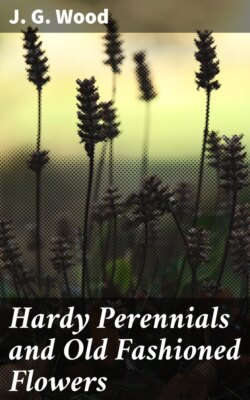Читать книгу Hardy Perennials and Old Fashioned Flowers - J. G. Wood - Страница 36
На сайте Литреса книга снята с продажи.
Arisæma Triphyllum.
ОглавлениеTable of Contents
Syns. A. Zebrinum and Arum Triphyllum; Common Names, Three-leaved Arum and Jack-in-the-Pulpit; Nat. Ord. Araceæ.
A hardy tuberous-rooted perennial from North America. I will at once explain that the above leading name is not the one generally used here, but in America, where the species is common, botanists have adopted it; besides, it is, as will be seen from the following description, very distinct from other Arums. The Syn. Arisæma zebrinum, as given, belongs really to a variety of A. triphyllum, but the type is marked in its flowers zebra-like, and there are many shades and colours of it, therefore both or either of the names may be used for the different forms, with a fair degree of propriety, as in fact they are.
There is a doubt with some as to the hardiness of this plant; in my mind there is none whatever. It is no stranger to frosts in its habitats, but I do not found my conviction on anything but my experience of it. It has been grown fully exposed for two winters, and sometimes the frosts must have gone as far down as the roots.
There is nothing showy about this plant, but there is something which stamps it as a fitting subject for a garden of choice plants; its bold, dark green foliage and quaint-looking flowers render it desirable on the score of distinctness. It has, moreover, a freshness upon which the eye can always linger. The flowers are in general form like the calla-lily; the upper part of the spathe, or sheathing leaf, which is really the calyx, is, however, more elongated, pointed, and hooked; otherwise the spathe is erect, slightly reflexed just above the folded part, giving the appearance of a pair of small lobes; this—the calyx—is really the most conspicuous part of the flower; in the belly it is beautifully striped with broad lines of a purplish-brown colour, which shade off to an inch of green in the middle, when they form again, and continue to the tip of the spathe, which will be 4in. to 6in. long, and nearly 2in. broad at the widest part; these lines run between the ribs, and, as before hinted, they are of various colours, such as brown, purple, pink, and green. The ribs are nearly white, and the green parts are very pale. The spadix is over 3in. long, club-shaped, spotted with brown, very much so near the end. The anthers at the base of the spadix are curious, and should be examined. They are invisible until the folded part of the spathe is opened; they are numerous, arranged in a dense broad ring, sessile, and nearly black. This curious flower is produced on a stout, round scape, a foot or more in height. The leaves are radical, having a stalk a foot long. They are, as the specific name implies, divided into three parts, each being of equal length, entire, wavy, and pointed. The whole plant has a somewhat top-heavy appearance (see Fig. 16), but I never saw it broken down by the weather. It makes quick growth in spring, the scape appearing with the leaves; in late summer it dies down. It looks well in quiet nooks, but it also forms a good companion to showy flowers in more open situations; in a cut state, for dressing "old-fashioned" vases, nothing could be in better character, a few leaves of yarrow, day lily, flag, or similar foliage being all it will require.
Fig. 16. Arisæma Triphyllum. (One-fourth natural size.)
It may be transplanted, any time from September to the end of January, into good light loam or leaf soil, 4in. or 6in. deep; if there should be a dry season during the period of growth, the plant should be well watered. To increase it, the tubers may be divided every third year, providing the growth has been of a vigorous tone. I may add, that, from its tall and not over-dense habit, there may with advantage, both to it and the plants used, be a carpet grown underneath—ivy, vincas, or sweet woodruff for some situations, and brighter subjects for more conspicuous parts of the garden, such as the finer kinds of mimulus, ourisia, alpine aster, and dwarf iris.
Flowering period, June and July.
